#image and source from Wikipedia
Text

Nurarihyon (ぬらりひょん) from Bakemono no e (化物之繪, c. 1700), Harry F. Bruning Collection of Japanese Books and Manuscripts, L. Tom Perry Special Collections, Harold B. Lee Library, Brigham Young University.
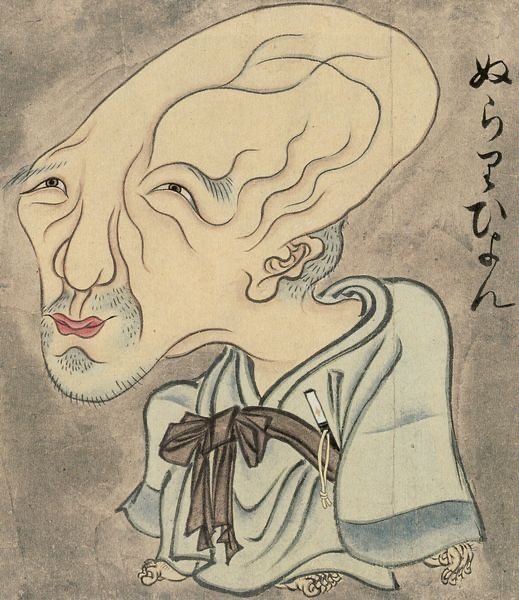
"Nurarihyon" from the Hyakkai Zukan by Sawaki Suushi
#Nurarihyon#yokai are so funny so many of them are like what if there was a weird guy would that be scary or what#image and source from Wikipedia
180 notes
·
View notes
Text

Hellsing 2002 calendar illustration.
Ein wunderliche und erschröckliche Hystori von einem großen Wüttrich genant Dracole wayda Der do so ganz unkristenliche marrter hat angelegt die mensche, als mit spissen als auch die leut zu Tod geslyffen
A wondrous and frightening story about a great berserk called Dracula the voivode who inflicted such unchristian tortures such as with stakes and also dragged people to death
#hellsing#alucard#kouta hirano#translation was found in a comment by u/lazyfoxheart on r/Kurrent#fun fact this is the highest quality version of this image that exists online#i know because i've been looking forever for a version that's clear enough to actually read what hirano wrote under '1443'#but there weren't any so i had to take matters into my own hands#the real image on the back of the guidebook is only 2 inches tall so i had to take this with my smartphone and will my hands not to shake#anyway i'm pretty sure it's supposed to say Eğrigöz (the location vlad was imprisoned) so yeah. thank you hirano very cool#if i might rant for a sec it took me an embarrassingly long time to figure that out because i didn't have the guidebook at first#and in the images i could find online that part was just a blur that looked suspiciously like a person's signature and i was like. who tf#i was thinking matthias corvinus since he issued some political propaganda against vlad iirc but it didn't match his signature on wikipedia#then i thought it might be vlad II dracul's since he probably had to sign an agreement to send his sons over as hostages at some point#but that didnt seem right either so i kept skimming vlad's wiki page#and then i was like goddammit...hirano.....you just misspelled Eğrigöz didn't you.. ....#i maybe should've made a separate post dedicated to this instead of writing a novel in the tags but eh#the hellsing brainrot runs deep#also- i put it in the source link at the bottom of the post but the german inscription is copied off a real woodcut of vlad from 1491#except instead of depicting him as an adult hirano drew him as a child which gives the inscription a very different feel imo#the one final thing that interests me about this is the fact that hirano published this calendar in 2002#which is REALLY early in the series. like this was before volume 5 came out??#i have no idea why he decided to do a massive spoiler drop in a random piece of japan-only merch#sandwiched between a drawing of alucard as john travolta from saturday night fever and integra as a fish no less#it makes me really curious to know what the fan response to this was back then. like did people even know who this was#maybe im just an idiot and everyone back then was like 'ah yes its alucard as a 12 year old. how very informative'
93 notes
·
View notes
Text
i must admit that this insult about rachmaninoff's first symphony from cesar cui is alright

but like, no one holds a candle to ivan ivanovich sollertinsky

#sollertinsky#ivan sollertinsky#rachmaninoff#cesar cui#cui#rare insults#insults#images sources: first is from wikipedia second is from a tchaikennugget video
15 notes
·
View notes
Note
you should credit who you took the wikipedia web weaving composition from
...?? it's...from wikipedia?? i put the composition together myself on that particular piece. i dont think. any one person invented the artform of cutting and pasting text and mixed media images into a digital drawing????
#unless you mean like??? citing the sources??? again it's From wikipedia it says it Right There in the Image. also from. uh. the bible#sorry anon this is absolutely baffling me do you think i drew the drawing on top of an existing composition???!?#asks#anonymous
8 notes
·
View notes
Text


A fractal mind
never constant
never solid
flowing like water through cracks formed by his own creation
plotholes never expound
details never nailed down
he races into eternity
as an ever-changing force of lightning
Never constant
never solid
he's made time and again
to come back anew
for an audience to spit at
never satisfied
never content
Try as they may
to work with what's given
so much held back
so much lost
and it builds on him again
an unprecedented loop
an unplanned chain of events
as words are written in his wake
for his voice
he's made new
Like quills through pinholes
they strike burrow through the walls built
to break through him
to show the world what he is
without the chains of any rules
Making do with what they have
it seems to be working
chipping away at bricks built up around him
building back up those lost beside him
But what of the chains upon crimson-streaked wrists?
Chrome silver matched with gold
so beautiful as a contrast
tries as he may to stay free
he cannot
How pathetic, it seems
one proud for himself cannot even be him
what he'd fought for so long
lost to the clutches of outsiders above
a puppet to his own existence
an antithesis of himself
Isn't it sad when unknown hands craft greater words than those forced by superiors?
When a child may understand a purpose better than an elder?
When love is so strong that it breaks every onlooker
before it is tossed away?
A spark crackles within
a flame kindling in the lonely heart
as the world shows potential
and the chains barely loosen
Waiting.
He's waiting.
He's waiting and he's hopeful.
Hopeful that he may see the sun again
may love the world again
may see his friends again
hopeful that minds change
that the chains may fall away
that he may be himself once more.
#old web finds#not my images#both images are found from very old sources#one of them from wikipedia commons iirc#old web#sth#sonic#poetry#kinda#my poetry#had a sudden burst of inspiration while listening to a Sonic FNF mod of all things#it's the Identity Crisis mod i believe#sonic the hedgehog#shadow the hedgehog#sorta a vent too#my writing
6 notes
·
View notes
Text
I cant believe this tweet is how I find out
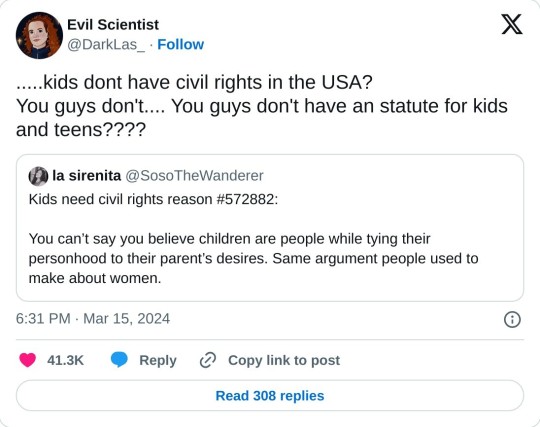

Edit: Now that we're talking about it, look. There is all the countries ratification dates, along with considerations for their laws.
And you can check the convention here.
Edit 2: For those in the US who want to check their state's laws compliance to the convention, there is this site.
Edit 3: The map source btw. Its from wikipedia.
Thank you people in the notes for the info and image desc.
52K notes
·
View notes
Text
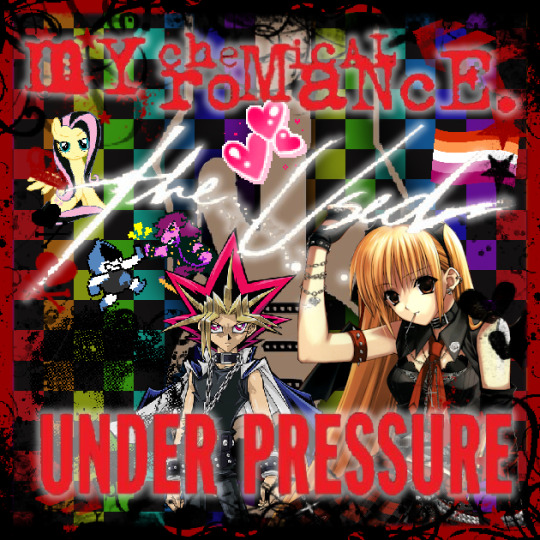
APRIL 12, 2005: a very happy anniversary to my chemical romance & the used's cover of david bowie & queen's 1981 song "under pressure", which was originally released to raise money for the 2004 indian ocean earthquake & tsunami!
#anniversary#april 12#i made this in a little over an hour (i take forever to make my silly edits) because i was like FUCKKK I HAVE AN HOUR AND A HALF LEFT#BEFORE THE DAY ENDS. but i made it (with like. 20 minutes to spare)#but like damnnnn my girl (this cover) turns 19 this year <- knows this off the top of his head because hes Also a 2005 baby#okay ive spent 10+ minutes digging up links for this just know at the time of posting it only had the link to the tsunami page.#will add the others in a mo#edit: first thing i have to edit to say. SORRY THIS IS SO ABSYMALLY LATE. i found out like at 10:30 est#and this is being posted at (checks watch) 11:56est#because my stupid ass spent fucking Forever (over an hour) making this image (worth it) and digging up source links#it literally says the date on wikipedia. you dont need to dig up the my chem site from 2005 on the wayback machine <- did that anyway#edit: me from like eight days later here. Forgot to add the date in the tags (its fixed now)
0 notes
Text
There is no such thing as AI.
How to help the non technical and less online people in your life navigate the latest techbro grift.
I've seen other people say stuff to this effect but it's worth reiterating. Today in class, my professor was talking about a news article where a celebrity's likeness was used in an ai image without their permission. Then she mentioned a guest lecture about how AI is going to help finance professionals. Then I pointed out, those two things aren't really related.
The term AI is being used to obfuscate details about multiple semi-related technologies.
Traditionally in sci-fi, AI means artificial general intelligence like Data from star trek, or the terminator. This, I shouldn't need to say, doesn't exist. Techbros use the term AI to trick investors into funding their projects. It's largely a grift.
What is the term AI being used to obfuscate?
If you want to help the less online and less tech literate people in your life navigate the hype around AI, the best way to do it is to encourage them to change their language around AI topics.
By calling these technologies what they really are, and encouraging the people around us to know the real names, we can help lift the veil, kill the hype, and keep people safe from scams. Here are some starting points, which I am just pulling from Wikipedia. I'd highly encourage you to do your own research.
Machine learning (ML): is an umbrella term for solving problems for which development of algorithms by human programmers would be cost-prohibitive, and instead the problems are solved by helping machines "discover" their "own" algorithms, without needing to be explicitly told what to do by any human-developed algorithms. (This is the basis of most technologically people call AI)
Language model: (LM or LLM) is a probabilistic model of a natural language that can generate probabilities of a series of words, based on text corpora in one or multiple languages it was trained on. (This would be your ChatGPT.)
Generative adversarial network (GAN): is a class of machine learning framework and a prominent framework for approaching generative AI. In a GAN, two neural networks contest with each other in the form of a zero-sum game, where one agent's gain is another agent's loss. (This is the source of some AI images and deepfakes.)
Diffusion Models: Models that generate the probability distribution of a given dataset. In image generation, a neural network is trained to denoise images with added gaussian noise by learning to remove the noise. After the training is complete, it can then be used for image generation by starting with a random noise image and denoise that. (This is the more common technology behind AI images, including Dall-E and Stable Diffusion. I added this one to the post after as it was brought to my attention it is now more common than GANs.)
I know these terms are more technical, but they are also more accurate, and they can easily be explained in a way non-technical people can understand. The grifters are using language to give this technology its power, so we can use language to take it's power away and let people see it for what it really is.
12K notes
·
View notes
Text
Medieval Scorpions Effortpost
So yesterday I reblogged this post featuring an 11th-century depiction of the Apocalypse Locusts from Revelations, noting the following incongruity as another medieval scorpion issue:
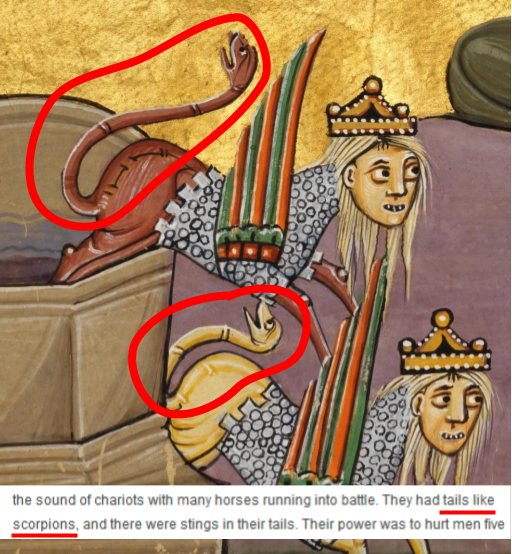
The artist, as you can see, has interpreted "tails like scorpions" as meaning "glue cheerful-looking snakes to their butts".
Anyway, it occurred to me that the medieval scorpion thing might not be as widely known as I think it is, and that Tumblr would probably enjoy knowing about it if it isn't known already. So, finding myself unable to focus on the research I'm supposed to be doing, I decided to write about this instead. I'll just go ahead and put a cut here.
As we can see in the image above, at least one artist out there thought a "scorpion" was a type of snake. Which makes it difficult to draw "tails like scorpions", because a snake's tail is not that distinctive or menacing (maybe rattlesnakes, but they don't have those outside the Americas). So they interpreted "tails like scorpions" as "the tail looks like a whole snake complete with head".
Let me tell you. This is not a problem unique to this illustration.
See, people throughout medieval Europe were aware of scorpions. As just alluded to, they are mentioned in the Bible, and if the people producing manuscripts in medieval Europe knew one thing, it was Stuff In Bible. They're also in the Zodiac, which medieval Europe had inherited through classical sources. However, let's take a look at this map:
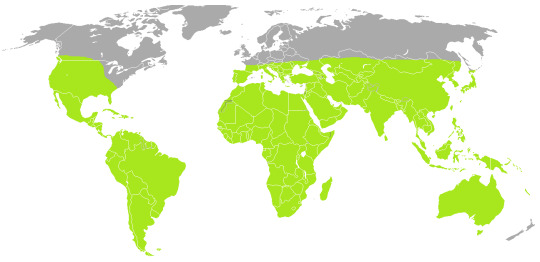
That's Wikipedia's map of the native range of the Scorpiones order, i.e., all scorpion species. You may notice something -- the range just stops at a certain northern latitude. Pretty much all of northern Europe is scorpion-free. If you lived in the north half of Europe, odds were good you had never seen a scorpion in your life. But if you were literate or educated at all, or you knew they were a thing, because you'd almost certainly run across them being mentioned in texts from farther south. And those texts wouldn't bother to explain what a scorpion was, of course -- everyone knows scorpions, right? When was the last time you stopped to explain What Is Spiders?
So medieval writers and artists in northern Europe were kind of stuck. There was all this scorpion imagery and metaphor in the texts they liked to work from, but they didn't really know what a scorpion was. Writers could kind of work around it (there's a lot of "oh, it's a venomous creature, moving on"), but sometimes they felt the need to break it down better. For this, of course, they'd have to refer to a bestiary -- but due to Bestiary Telephone and the persistent need of bestiary authors to turn animals into allegories, one of the only visual details you got on scorpions was that they... had a beautiful face, which they used to distract people in order to sting them.
And look. I'm not here to yuck anyone's yum, but I would say that a scorpion's face has significant aesthetic appeal only for a fairly small segment of the population. I'm sure you could get an entomologist to rhapsodize about it a bit, but your average person on the street will not be entranced by the face of a scorpion. So this did not help the medieval Europeans in figuring out how to depict scorpions. There was also some semantic confusion -- see, in some languages (such as Old and Middle English), "worm" could be a general term for very small animals of any kind. But it also could mean "serpent".* So there were some, like our artist at the top of the post, who were pretty sure a scorpion was a snake. This was probably helped along by the fact that "venomous" was one of the only things everyone knew about them, and hey, snakes are venomous. Also, Pliny the Elder had floated the idea that there were scorpions in Africa that could fly, and at least one author (13th-century monk Bartholomaeus Anglicus) therefore suggested that they had feathers. I don't see that last one coming up much, I just share it because it's funny to me.
*English eventually resolved this by borrowing the Latin vermin for very small animals, using the specialized spelling wyrm for big impressive mythical-type serpents, and sticking with the more specific snake for normal serpents.
Some authors, like the anonymous author of the Ancrene Wisse, therefore suggested that a scorpion was a snake with a woman's face and a stinging tail. (Everyone seemed to be on the same page with regards to the fact that the sting was in the tail, which is in fact probably the most recognizable aspect of scorpions, so good job there.) However, while authors could avoid this problem, visual artists could not. And if you were illustrating a bestiary or a calendar, including a scorpion was not optional. So they had to take a shot at what this thing looked like.
And so, after this way-too-long explanation, the thing you're probably here for: inaccurate medieval drawings of scorpions. (There are of course accurate medieval drawings of scorpions, from artists who lived in the southern part of Europe and/or visited places where scorpions lived; I'm just not showing you those.) And if you find yourself wondering, "how sure are you that that's meant to be a scorpion?" -- all of these are either from bestiaries or from calendars that include zodiac illustrations.
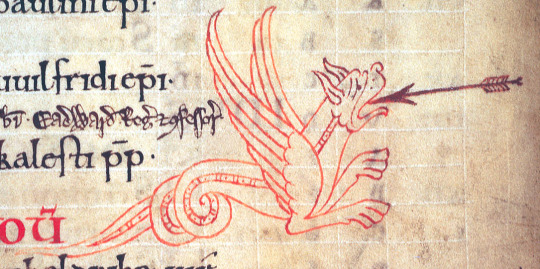
11th-century England, MS Arundel 60. (Be honest, without the rest of this post, if I had asked you to guess what animal this was supposed to be, would you have ever guessed “scorpion”?)
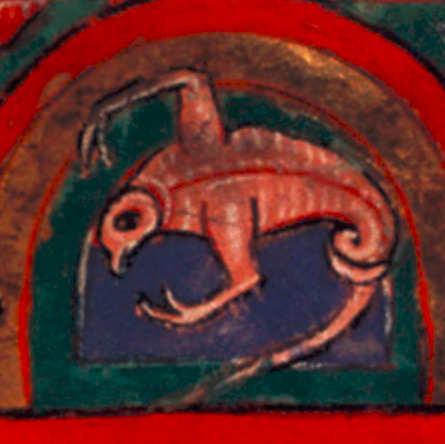
12th-century Germany, "Psalter of Henry the Lion". (Looks a bit undercooked. Kind of fetal.)
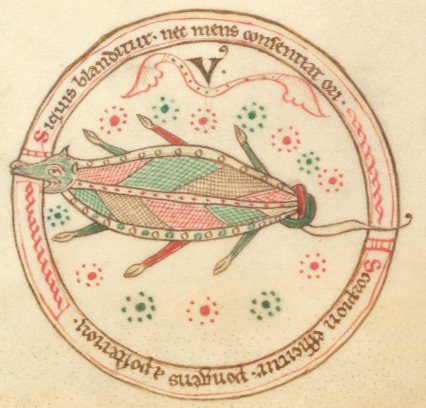
12th-century France, Peter Lombard's Sententiae. (Very colorful, itsy bitsy claws, what is happening with that tail?)
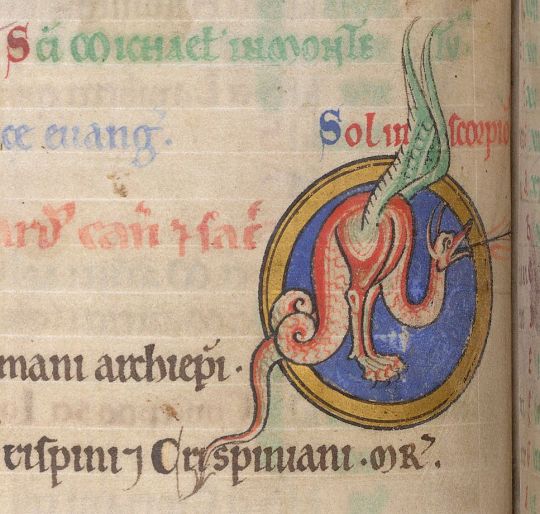
12th-century England, "The Shaftesbury Psalter". (So a scorpion is some sort of wyvern with a face like a duck, correct?)

13th-century France, Thomas de Cantimpré's Liber de natura rerum. (I’d give them credit for the silhouette not being that far off, but there’s a certain bestiary style where all the animals kind of look like that. Also note how few of these have claws.)
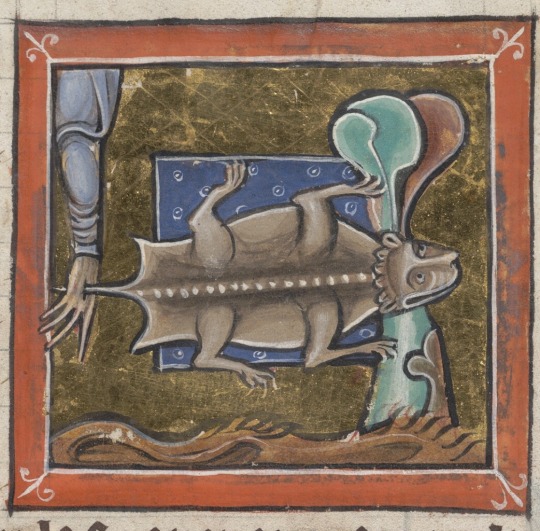
13th-century England, "The Bodley Bestiary". (Mischievous flying squirrel impales local man’s hand, local man fails to notice.)
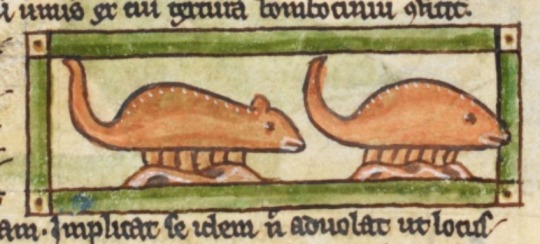
13th-century England, Harley MS 3244. (A scorpion is definitely either a mouse or a fish. Either way it has six legs.)
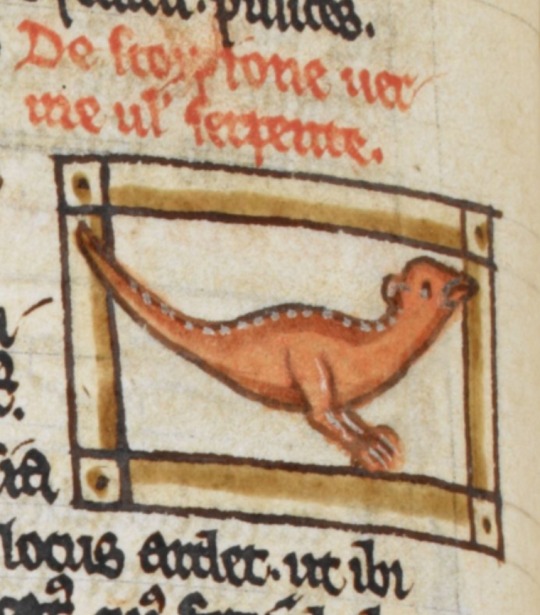
13th-century England, Harley MS 3244. (Wait, no, it’s a baby theropod, and it has two legs. (Yes, this is the same manuscript, that’s not an error, this artist did four scorpions and no two are the same.))

13th-century England, Harley MS 3244. (Actually it’s a lizard with tiny ears and it has four legs.)

13th-century England, Harley MS 3244. (Now that we’re at the big fancy illustration, I think I’ve got it — it’s like that last one, but two legs, longer ears, and a less goofy face. Also I’ve decided it’s not pink anymore, I think that was the main problem.)

13th-century England, MS Kk.4.25. (A scorpion is a flat crocodile with a bear’s head.)
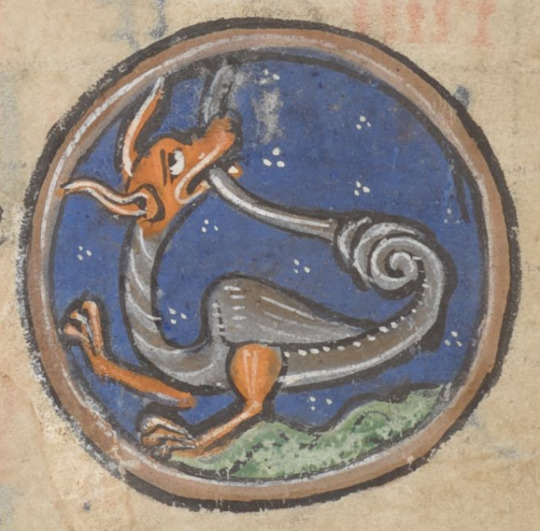
13th-century England, "The Huth Psalter". (Wyvern but baby! Does not seem to be enjoying biting its own tail.)
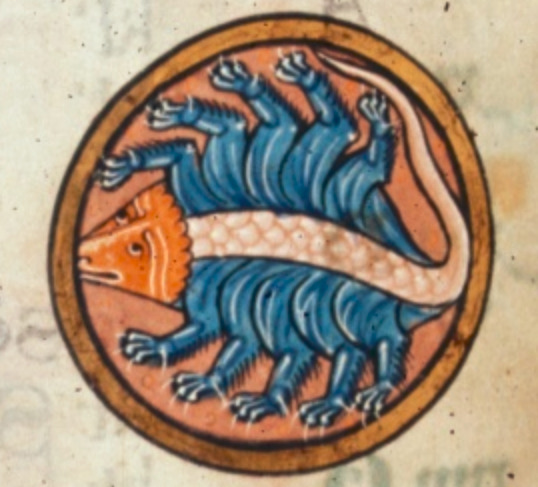
13th-century England, MS Royal 1 D X. (This triangular-headed gentlecreature gets the award for “closest guess at correct limb configuration”. If two of those were claws, I might actually believe this artist had seen a scorpion before, or at least a picture of one.)

13th-century England, "The Westminster Psalter". (A scorpion is the offspring of a wyvern and a fawn.)
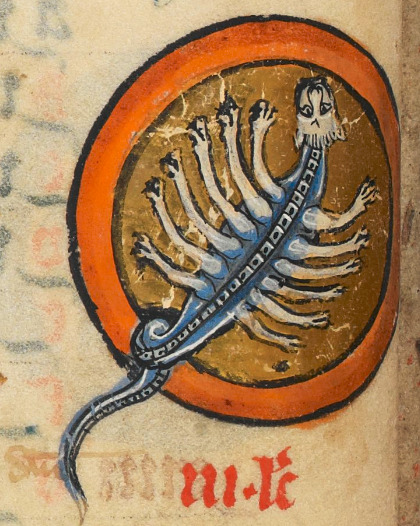
13th-century England, "The Rutland Psalter". (Too many legs! Pull back! Pull back!)

13th or 14th-century France, Bestiaire d'amour rimé. (This is very similar to the fawn-wyvern, but putting it in an actual Scene makes it even more obvious that you’re just guessing.)
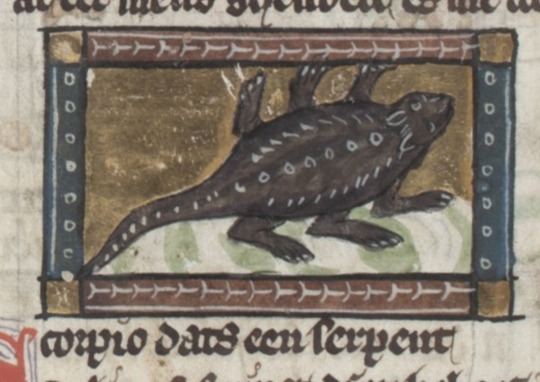
14th-century Netherlands, Jacob van Maerlant's Der Naturen Bloeme. (More top-down six-legged guys that look too furry to be arthropods.)

14th-century Germany, MS Additional 22413. (That is clearly a turtle.)

14th-century France, Matfres Eymengau de Beziers's Breviari d'amor. (Who came up with that head shape and what was their deal?)
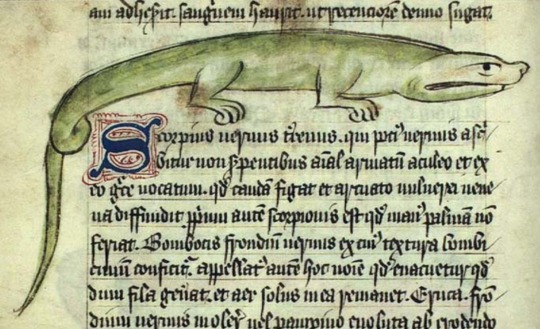
15th-century England, "Bestiary of Ann Walsh". (Screw it, a scorpion is a big lizard that glares at you for trying to make me draw things I don’t know about.)
I've spent way too much time on this now. End of post, thank you to anyone who got all the way down here.
#medieval#medieval creatures#medieval art#scorpions#medieval scorpions#manuscript#medieval manuscripts#illuminated manuscript
6K notes
·
View notes
Text
🌊Sad Soggy Boat Men Tournament🌊
Round 4A (semifinals), match 1

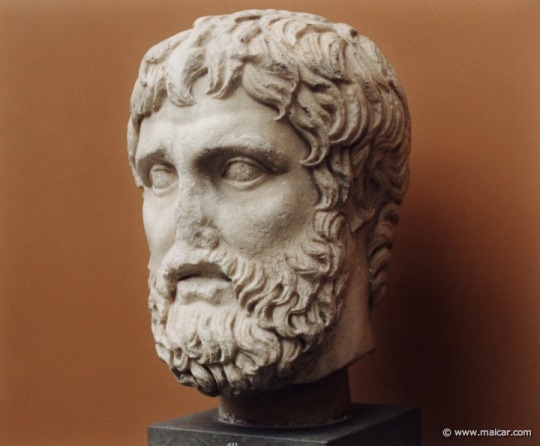
Propaganda and image sources under the cut (warning for possible spoilers):
propaganda for Odysseus:


image from Wikipedia
propaganda for Aeneas:

image from here
1K notes
·
View notes
Text
I recently found out a show I liked is 10 years old now so to not be the oldest thing on this blog I'm talking coelacanths for Wet Beast Wednesday. Coelacanths are rare fish famed for being living fossils. While that term is highly misleading, it is true that coelacanths are among the only remaining lobe-fined fish and were thought to have gone extinct millions of years ago before being rediscovered in modern times.
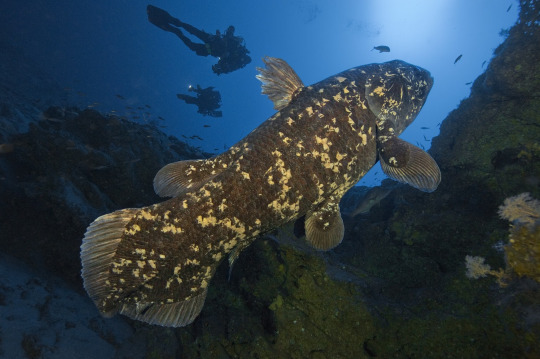
(image id: a wild coelacanth. It is a large, mostly grey fish with splotches of yellowish scales. Its fins are attached to fleshy lobes. It is seen from the side, facing the top right corner of the picture)
Coelacanth fossils had been known since the 1800s and they were believed to have gone extinct in the late Cretaceous period. That was until December 1938, when a museum curator named Marjorie Courtenay-Latimer was informed of an unusual specimen that had been pulled in by local fishermen. After being unable to identify the fish, she contacted a friend, ichthyologist J. L. B. Smith, who told her to preserve the specimen until he could examine it. Upon examining it early next year, he realized it was indeed a coelacanth, confirming that they had survived, undetected, for 66 million years. Note that fishermen living in coelacanth territory were already aware of the fish before they were formally described by science. Coelacanths are among the most famous examples of a lazarus taxon. This term, in the context of ecology and conservation, means a species or population that is believed to have gone extinct but is later discovered to still be alive. While coelacanths are among the oldest living lazarus taxa, they aren't the oldest. They are beaten out by a genus of fly (100 million years old) and a type of mollusk (over 300 million years old).

(image: a coelacanth fossil. It is a dark brown imprint of a coelacanth on white rock. Its skeleton is visible in the imprint)
Coelacanths are one of only two surviving groups of lobe-finned fish along with the lungfishes. Lobe-finned fish are bony fish notable for their fins being attached to muscular lobes. By contrast, ray-finned fish (AKA pretty much every fish you've ever heard of that isn't a shark) have their fins attached directly to the body. That may not sound like a big difference, but it actually is. The lobes of lobe-finned fish eventually evolved into the first vertebrate limbs. That makes lobe-finned fish the ancestors of all reptiles, amphibians, and mammals, including you. In fact, you are more closely related to a coelacanth than a coelacanth is to a tuna. Coelacanths were thought to be the closest living link to tetrapods, but genetic testing has shown that lungfish are actually closer to the ancestor of tetrapods.
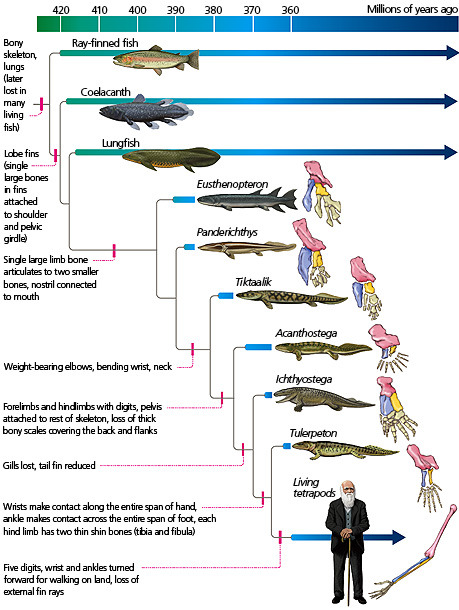
(image id: a scientific diagram depicting the taxonomic relationships of early lobe-finned fish showing their evolution to proto-tetrapods like Tiktaalik and Ichthyostega, to true tetrapods. Source)
There are two known living coelacanth species: the west Indian ocean coelacanth (Latimeria chalumnae) and the Indonesian coelacanth (L. menadoensis). Both are very large fish, capable of exceeding 2 m (6.6 ft) in length and 90 kg (200 lbs). Their wikipedia page describes them as "plump", which seems a little judgmental to me. Their tails are unique, consisting of two lobes above and below the end of the tail, which has its own fin. Their scales are very hard and thick, acting like armor. The mouth is small, but a hinge in its skull, not found in any other animal, allows the mouth to open extremely wide for its size. In addition, they lack a maxilla (upper jawbone), instead using specialized tissue in its place. They lack backbones, instead having an oil-filled notochord that serve the same function. The presence of a notochord is the key characteristic of being a chordate, but most vertebrates only have one in embryo, after which it is replaced by a backbone. Instead of a swim bladder, coelacanths have a vestigial lung filled with fatty tissue that serves the same purpose. In addition to the lung, another fatty organ also helps control buoyancy. The fatty organ is large enough that it forced the kidneys to move backwards and fuse into one organ. Coelacanths have tiny brains. Only about 15% of the skull cavity is filled by the brain, the rest is filled with fat.

(image id: a coalacanth. It is similar to the one on the above image, but this one is blue in color and the head is seen more clearly, showing an open mouth and large eye)
One of the reasons it took so long for coelacanths to be rediscovered is their habitat. They prefer to live in deeper waters in the twilight zone, between 150 and 250 meters deep. They are also nocturnal and spend the day either in underwater caves or swimming down into deeper water. They typically stay in deeper water or caves during the day as colder water keeps their metabolism low and conserves energy. While they do not appear to be social animals, coelacanths are tolerant of each other's presence and the caves they stay in may be packed to the brim during the day. Coelacanths are all about conserving energy even when looking for food. They are drift feeders, moving slowly with the currents and eating whatever they come across. Their diet primarily consists of fish and squid. Not much is known about how they catch their prey, but they are capable of rapid bursts of speed that may be used to catch prey and is definitely used to escape predators. They are believed to be capable of electroreception, which is likely used to locate prey and avoid obstacles. Coelacanths swim differently than other fish. They use their lobe fins like limbs to stabilize their movements as they drift. This means that while coelacanths are slow, they are very maneuverable. Some have even been seen swimming upside-down or with their heads pointed down.
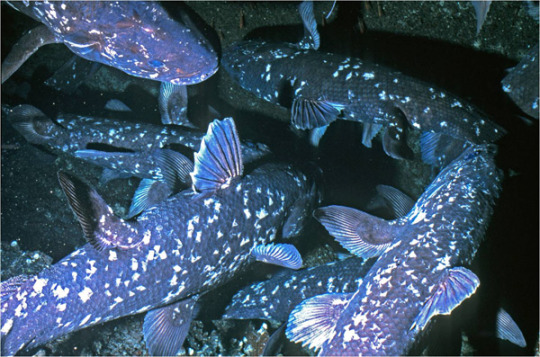
(image: an underwater cave wilt multiple coelacanths residing in it. 5 are clearly visible, with the fins of others showing from offscreen)
Coelacanths are a vary race example of bony fish that give live birth. They are ovoviviparous, meaning the egg is retained and hatches inside the mother. Gestation can take between 2 and 5 years (estimates differ) and multiple offspring are born at a time. It is possible that females may only mate with a single male at a time, though this is not confirmed. Coelacanths can live over 100 years and do not reach full maturity until age 55. This very slow reproduction and maturation rate likely contributes to the rarity of the fish.

(image: a juvenile coelacanth. Its body shape is the same as those of adults, but with proportionately larger fins. There are green laser beams shining on it. These are used by submersibles to calculate the size of animals and objects)
Coelacanths are often described as living fossils. This term refers to species that are still similar to their ancient ancestors. The term is losing favor amongst biologists due to how misleading it can be. The term os often understood to mean that modern species are exactly the same as ancient ones. This is not the case. Living coelacanth are now known to be different than those who existed during the Cretaceous, let alone the older fossil species. Living fossils often live in very stable environments that result in low selective pressure, but they are still evolving, just slower.
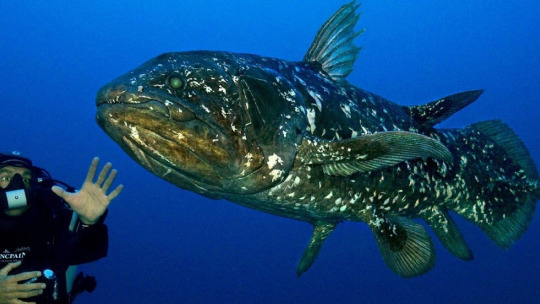
(image: a coelacanth swimming next to a SCUBA diver)
Because of the rarity of coelacanths, it's hard to figure out what conservation needs they have. The IUCN currently classifies the west Indian ocean coelacanth as critically endangered (with an estimated population of less than 500) and the Indonesian coelacanth as vulnerable. Their main threat is bycatch, when they are caught in nets intended for other species. They aren't fished commercially as their meat is very unappetizing, but getting caught in nets is still very dangerous and their slow reproduction and maturation means that it is long and difficult to replace population losses. There is an international organization, the Coelacanth Conservation Council, dedicated to coelacanth conservation and preservation.
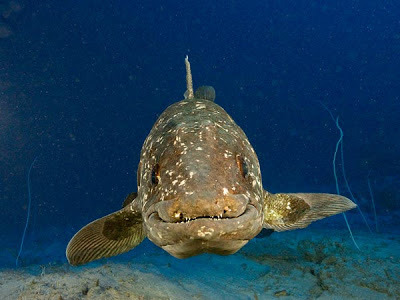
(image: a coelacanth facing the camera. The shape of its mouth makes it look as though it is smiling)
#wet beast wednesday#coelacanth#marine biology#biology#zoology#ecology#animal facts#fish#fishblr#old man fish#lobe-finned fish#sarcopterygii
1K notes
·
View notes
Text
What kind of saber is baxia anyway?
I love my bloodthirsty princess of a cursed blade, and in my heart of hearts i am nothing but a sword nerd, so i've been extremely fascinated by Baxia and how we know frustratingly little about what she actually looks like!
I mean, look at bichen, right?
Bichen in the donghua:
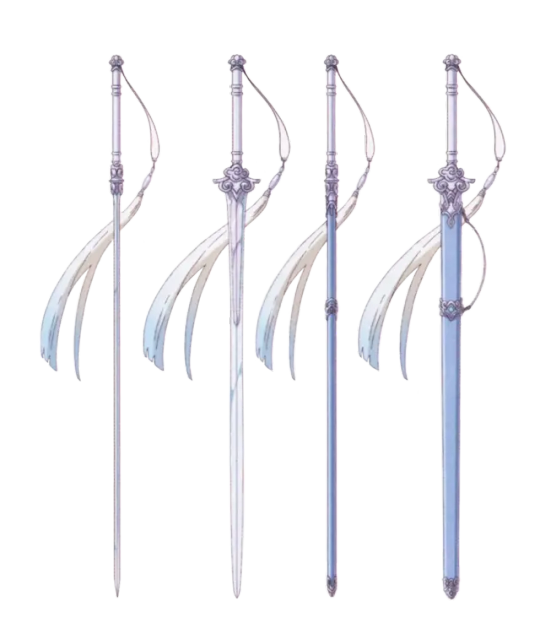
Bichen in the drama:
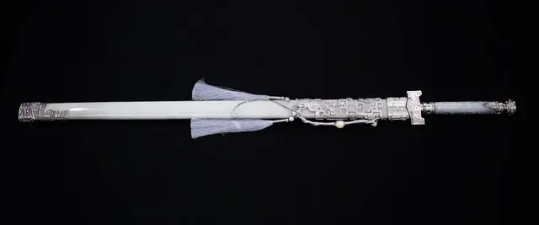
They're clearly not exactly the same. The scabbards are different, and the guards have a different shape. But these are recognizably different iterations on one theme, right? Thin jian with a white grip silver guard, light blue tassel and silver mounting accents on the scabbard.
Now this is baxia in the donghua:
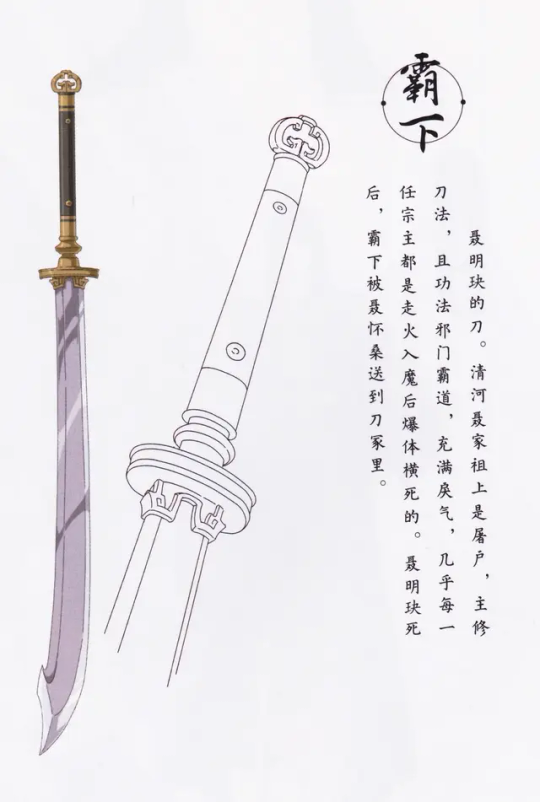
And baxia in the drama:

????????
THAT'S A COMPLTELY DIFFERENT WEAPON
it doesn't stop there either, the audio drama is kind enough to give us ANOTHER COMPLETELY DIFFERENT BAXIA

pretty! But how is that he same sword??
And when we go back to the novel, we get very little information on her appearance other than the fact that her blade is tinted red with all the blood she's absorbed. Which none of these designs incorporate.
This is not a dig on the designs itself, they're all quite gorgeous in their own right and i'm going to spend a while discussing all of them! Because isn't it fascinating how, since we know little about novel baxia beyond "saber" all of these designs ended up so different? What kinds of sabers are these, anyway?
So, a chinese aber, aka a "dao" (刀) just means a sword that has only one cutting side. As opposed to a jian, which has two.
You can see how that leaves a LOT of room for variaton.
I've actually seen some people get confused because Huaisang's saber in the untsmed is thin and quite straight, making it superficially resemble the jian more than drama!baxia, but it is still clearly a saber!
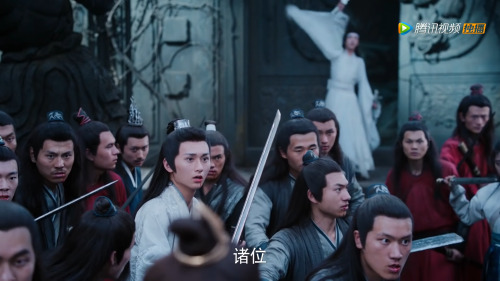
See? only one cutting blade!
This, to me looks a lot like a tang dynasty hengdao
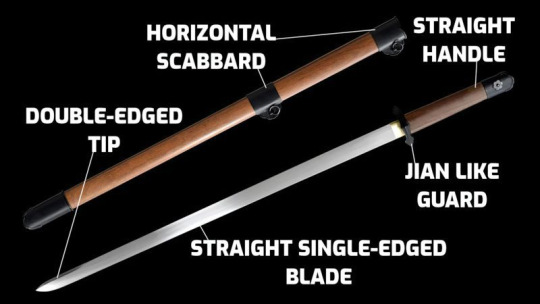
credit to this blog for providing his image and being a great source for all this going forward.
TANGENT: during all this I found out the english wikipedia page for dao is WRONG! Ths is what they about the tang hengdao!

So that sounds like the hengdao was called that during the sui dynasty, but then, after that, started being called a peidao, right?
WRONG
I LOOKED AT THE SOURCE THEY USED AND IT SAYS THIS:

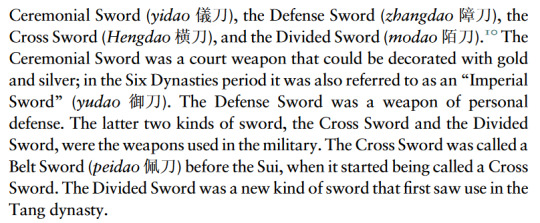
IT WAS CALLED THE PEIDOU UNTIL THE SUI DYNASTY, AT WHICH POINT IT WAS CALLED A HENGDAO. Which would carry over to the Tang dynasty. This was the source wikipedia linked! and it says something else than they say it does!
Anyone know how to edit a wikipedia article?
ANYWAY
BACK TO BAXIA
Since we're already at the drama, let's look at drama baxia: She's also straight! the general term for straight-backed saber is Zhibeidao, but that's a modern collector's term, and doesn't really say anything about which historical kind of saber baxia could be based on. Another meta i found on the drama nie sabers already went on some detail here.
I'm gonna expand on that a little: The kinds of historical straight-backed sabers we see resemble the hengdao a lot more than they do baxia. They don't go to their point as harsly as she does (she's basically a cleaver!) and they're all way skinnier.
No, my personal theory is that instead of being based on any kind of historical sword, drama!baxia is based on a Nandao.

I mean, come on, look at it!
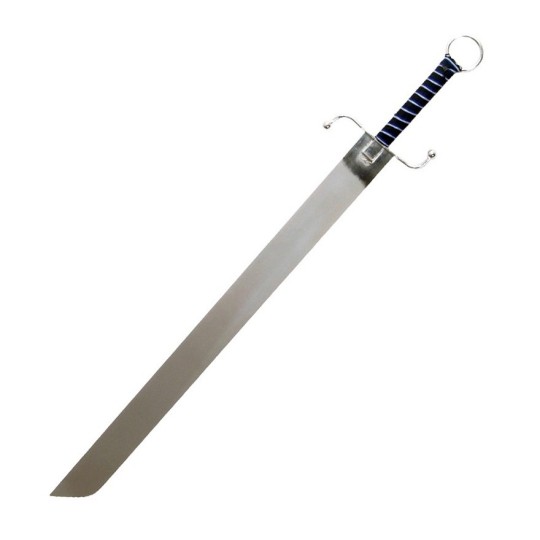
Baxia!
The Nandao... isn't actually a historical sword. It was invented for Wushu forms. There's a really fascinating article about its conception, but that's why the swords in the images look a little thin and flimsy. Wushu swords are very flexible and light, they're dance props, not weapons to fight with. There are actual steel versions of Nandao, but they're recreations of the prop, not the other way around.
So That's one way in which Baxia differes from the Nandao: she's actually a real weapon. The other is that, as you can see above, the nandao has an S-shaped guard. Baxia doesn't. She's also much more elaborately decorated, of course. Because she's a princess.
Now: audio drama baxia!
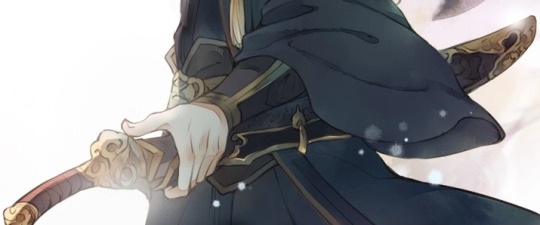
This is much easier. with that flare at the tip?
Oh baby that's a niuweidao, all the way!

There are more sabers with that kind of curved handle, but the broad tip is really charcteristic of the niuweidao. The Niuweidao is also incredibly poplar in modern media, often portrayed as a historical sword, but it originated i nthe 19th century! And it was actually never used by the military!
That's right, the Niuweidao was pretty much exclusively a civilian weapon! That makes its use here anachronistic, but so is the nandao, and considering that the origin story of the Nie is that they use Dao intead of Jian because their ancestors were butchers, portraying them with a weapon historically reserved for rebels and common people instead of the imperial military is actually very on theme!
Finally, Donghua/Manhua baxia. These two designs are so similar I'm going to treat them as one and the same for now.
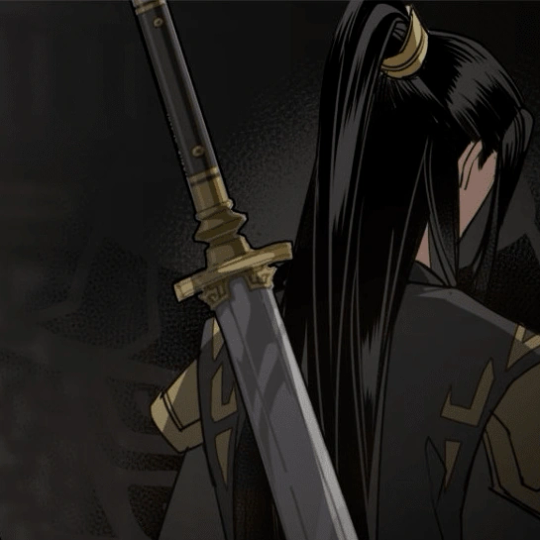
Unlike both previous baxias, The long handle makes it clear this baxia is a two-handed weapon, though Nie Mingjue is absolutely strong enough to wield her with one hand anyway. Normal rules don't count for cultivators.
Now, this is where things get tricky, because there are a lot of words for long two-handed sabers. And a lot of them are interchangable! This youtube video about the zhanmadao, one of the possible sabers this baxia could be based on, goes a little into just how confusing this can get. This kind of blade WAS actually in military use for many centuries, making it the most historically accurate of all the baxias. But because of that it also has several names and all of those names can also refer to different kinds of blades depending on what century we're in.
So here's our options: i'm going to dismiss the wodao and miandao, because these were explicitly based on japanese sword design, and as we can see manhua baxia has that very broad tip, so that won't work

(Example of a wodao. According to my sources Miaodao is really just the modern common term for the wodao, and the changdao, and certain kinds of zhanmadao... do you see how quickly this gets confusing?)
Next option: Zhanmadao.
Zhanmadao stands for "horse chopping saber" so... yeah they were anti-cavalry weapons. meant to be able to cut the legs and/or necks of horses. That definitely sounds like a weapon Nie Mingjue would wield. But if you watched that youtube video i linked above, you'll know the standardized Qing dinasty Zhanmadao looked very different from earlier versions. It was inspired by the japanese odachi, and more resembles the miandao than its ealrier heftier counteprarts.
Earlier Ming dynasty Zhanmadao on the other hand were... basically polearms. the great ming military blog spot, another wonderful source, says these are essentially a kind of podao/pudao (朴刀) which looked like this
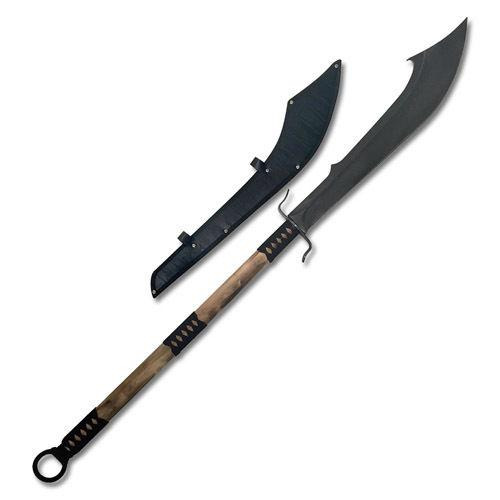
Now that blade looks a lot like baxia, but the handle is honestly too long. Donghua!baxia straddles the line between sword an polearm a little, but while zhanmadao have been used to refer to both long-handled swords and polerarms, this was undeniably a polearm, not a sword.
If you want to know what researching this was like, I found a picture of this blade on pinterest-- labeled as a "two-handed scimitar"-- and the comment section was filled with people arguing about whether this was a Pudao, Wudao, Zhanmadao, Dadao, Guandao, or a japanese Nagita.
So... that's how it was going. This has kept me up until 2 AM multiple times.
However! Thanks to this article on the great ming military blog I found out there have historically been pudao blades with shorter handles!
Specifically, Ming dynasty military writer Cheng Ziyi created a modified version of the pudao to work with the Dan Fao Fa Xuan technixues-- aka technqiues for a two-handed saber, which would alter heavily influence Miaodao swordmanship-- thereby, as the article points out, essentially merging the cleaver-polearm type Zhanmadao with the later two-handed japanese-inspired design.
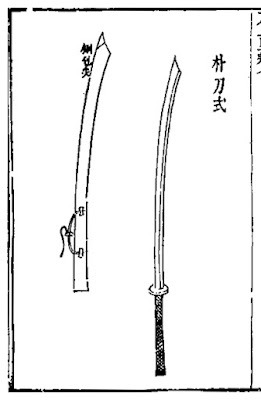
This is the illustration for the Wu Bei Yao Lue (武備要略) a Ming dynasty military manual
This blade shape in the illustration doesn't match Baxia exactly, but since it's a lengthened Pudao-like blade and we've seen above that those can match Donghua Baxia's shape, i'm gonna say that calling Baxia a Zhanmadao with a two-handed grip isn't all that innacurate!
However, because all of these terms are so intertwined, there are a dozen other things you could call her that would be about equally correct.
To show that, here's a lightning round of other potential Baxia candidates:
Dadao (大刀)
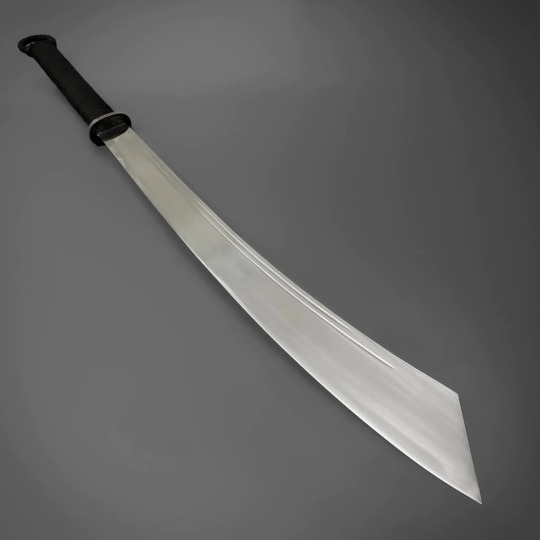
Which are generally one-handed and too short. However!
Another youtube video i found of someone training with a Zhanmadao that resembles baxia a little also calls it a "shuangshoudai dao" (雙手带 刀) shuangshou means two-handed, and while 雙手带 seems to refer to a longer handled weapon, when looking for a shuangshou dao or shuangshou dadao (双手大刀) we find a lot more baxia-resembling blades like here and here
I also found that, while the cleaver-like Dadao is strictly a product of the 20th centuy, since dadao just means big sword or big knife, it has been used to refer to loads of different weapons! Some people could've called the zhanmadao and pudao "dadao" during the Ming dynasty as well.
Another potential baxia candidate that mandarin mansion classifies as similar to the later dadao (though longer, as seen in the illustration below) is the "Kuanren Piandao"
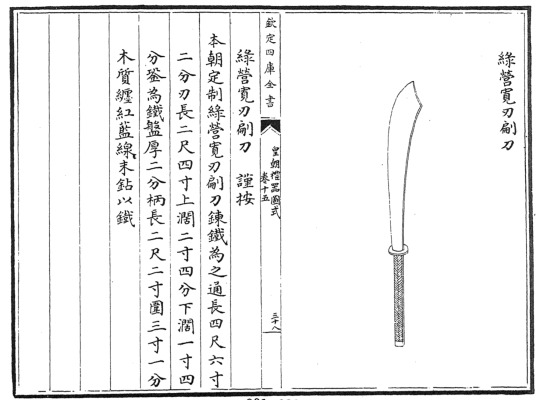
Which piqued my interest because this diagram classifying different tpye of Dao:
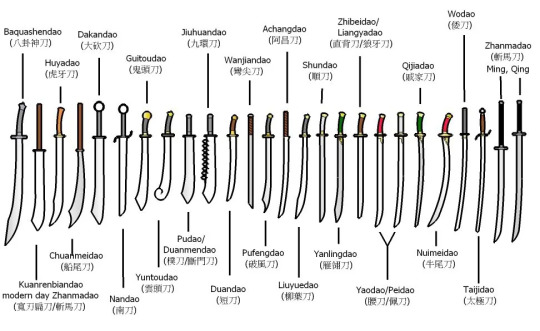
Claims that a Kuanrenbiandao (diferent spelling, same sword) is the same as a modern day Zhanmadao.
(So once again, all of these terms are interchangable)
Another opton Is the Chuanmeidao/Chuanweidao (船尾刀) below you can see a diagram, based on the Qing dynasty green standard army regulation, of blades all officially classified as types of "pudao"
The top middle is the Kuanren Piandao, and bottom left is the Chuanweidao.
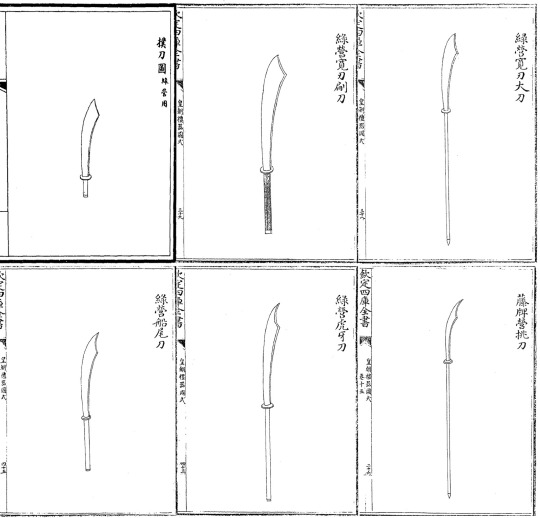
Both of these have a lot of baxia-like qualities.
So there you go! live action baxia is based on a Nandao, audio drama baxia is based on a Niuweidao, and Manhua/donghua baxia is some kind of two-handed Zhanmadao/Pudao/Dadao depending on how you want to look at it.
I'm honestly surprised no one has made the creative decision to portray Baxia as a Jiuhuandao, aka 9 ringed broadsword yet.

I mean look at it! Incredibly imposing. Would make for a great Baxia imo. (@ upcoming mdzs manga and mobile game: take notes!)
#mdzs#mdzs meta#nie mingjue#baxia#cql#the untamed#long post#I HAVE SO MANY TABS OPEN. FEEL MY SUFFERING#I understand that asking a gigantic region with thousands of years of rich history and many different subcultures#to have one standard naming convention is basically impossible#But could they do it anyway? for me? 🥺#i also want to buy one of these... so bad#or even just a plastic trainer so i can practice the techniques#but i know that once i start buying swords i'm not gonna stop until my money runs out#Being a sword nerd is a very dangerous not phyisically but for your wallet
457 notes
·
View notes
Photo

European countries with most produced fruits and vegetables by value
by visvis
Data source: FAO Value of Agricultural Production, 2019
It is sometimes hard to determine what is and what is not a fruit or vegetable. Many plants that are fruits or vegetables in a botanical sense are not considered such in a culinary sense. From the FAO list, I have excluded all products of animal origin, all nuts and seeds, all products used for their oil (in particular, olives), grains (in particular, maize), and all starchy foods typically used as the carbohydrate part of the meal (in particular, potatoes). I did include beans as vegetables. These choices are somewhat arbitrary, and can even differ between countries, but I think this best reflects what people typically perceive to be fruits and vegetables.
In terms of countries, I included those listed by FAO as part of Europe (note: there is no data for Montenegro and Kosovo) and additionally Turkey and Cyrprus (bothof which FAO considers to be Western Asia).
Background map: [Wikipedia](https://en.wikipedia.org/wiki/File:Blank_map_of_Europe_(without_disputed_regions).svg)
Drawings: clipart-library and kindpng
Please note that the sizes have no meaning, images are simply scaled down if they would not fit otherwise
402 notes
·
View notes
Text
I’ve had it with ignorant anime blogs who learned the world Palestine about 5 days ago
….(through social media of course) Telling me, a Jewish Israeli women, who has been living through this conflict her entire life - that I’m wrong.
They never have credible examples yet they’re constantly asking me for proof for my people’s biggest massacre since the holocaust.
When something doesn’t fit your narrative it propaganda:
When I provide actual evidence and proof- Its propaganda.
-the sad truth is that anti Zionists believe literal Hamas propaganda
Then they move on to patronising me and making gross generalisation of an entire 10 million people country. It always something along the lines of
“Oh no sweetie you’re so brainwashed you don’t understand “. Bruh I live 2 hours away from Gaza, this is my own country, there’s been a terror attack just yesterday.
And finally- they ask for proof. I’ve come to hate that word.
Anti Zionists are a quick to believe a literal terror organisation then listen to Jews and educate themselves.
-A quick google search will prove you wrong.
-I’ve made dozens of posts about the conflict and Jewish history. All of them include *credible* sources and statistics, images , graphs, links to articles and examples.
-Al Jazeera isn’t a credible news and information source*: it’s racist, antisemitic and heavily biased. It’s filled with Hamas propaganda- they literally call terrorists “martyrs”.
*(Ive made a more detailed post about that as well )
-once again, Hamas literally live streamed their crimes.
Your ignorance and antisemitic rhetoric is showing. You lack basic understanding of history and key terms.
-you clearly don’t know what the word Zionism even means.
The fact that I found a tag saying “Zionism is terrorism”🤡🤦♀️
——-
As always here are some articles & posts to educate yourself:
https://www.terrorism-info.org.il/en/evidence-of-the-terrorist-organizations-use-of-civilian-facilities-in-the-gaza-strip/
instagram
instagram
instagram
#israeli palestinian conflict#jewish#israel hamas war#israeli#jewblr#israel palestine conflict#israel#gaza strip#zionsim is terrorism#טאמבלר ישראלי#ישראל#hamas is isis#human rights#Gaza#gaza strikes#news on gaza#jewish ≠ israel#israel is a terrorist state#Yemen#current events#middle east#ישראלי#anti zionism#Instagram
161 notes
·
View notes
Text

Asteroid Tantalus (2102): Understanding Its Signs, Houses, and Planetary Aspects

Navigation: Masterlist✦Ask Rules✦Feedback Tips
Askbox✦Sources✦Paid Readings

₊· ͟͟͞͞➳❥ About the Asteroid: Tantalus is a mythological figure. Once, daring to test the omniscience of the gods, he stole the divine delicacies and served them the flesh of his own son Pelops at a feast. As a punishment, he was cast into Tartarus, where, in a valley abundant in vegetation and water, he was sentenced to not being able to quench his hunger and thirst, since, when he approached the water, it drained and when he rose to gather the fruits of the trees , the branches moved out of reach under the force of the wind. The expression torment of Tantalus refers to the suffering of the one who wants something apparently close, however, unattainable, like the popular saying "So close and yet so far" - Wikipedia .
˚₊· ͟͟͞͞➳❥ Sources and inspirations: As I said, Tantalus is known for his eternal punishment for his unforgivable acts by the gods. As it is an asteroid, in a natal chart, I cannot see it as a great punishment for the individual, but more as something that, if done out of pure ego, will be severely punished. My sources were my astro mutual @a-d-nox. Also, the image template in from minikyuns on deviantart.
˚₊· ͟͟͞͞➳❥ Asteroid Tantalus Rx: When this asteroid is in retrograde, the individual may turn their attention inward. They might reflect on the themes associated with Tartalus, such as power, authority, ego, and responsibility. This introspective phase can lead to a deeper understanding of how they've handled these themes in the past and how they wish to navigate them in the future.
Asteroid Tantalus in Signs
·˚ ꒰ Aries꒱This placement amplifies your desire for authority and leadership. You might be tempted to exploit your power or rush into decisions without considering their consequences. Your ambition and drive can sometimes border on egotism, making it essential to balance self-assurance with humility. You might also find that your impulsive actions hinder the attainment of your long-term goals, urging you to cultivate patience and strategic thinking. This placement encourages you to learn the art of measured action and to appreciate the journey rather than just the destination.
·˚ ꒰ Taurus꒱ There's a risk of overindulgence and an insatiable hunger for material possessions. This can lead to an inflated sense of self-worth and a tendency to disregard the needs of others. You may also struggle with authority figures and the misuse of power. Be cautious of impulsively reaching for possessions or financial gains without considering the long-term consequences. Recognizing when you're reaching for the unattainable can help you avoid unnecessary frustrations, leading to more stable and harmonious material pursuits.
·˚ ꒰ Gemini꒱ This placement might cause you to misuse your verbal prowess for personal gain . You may engage in superficial relationships to bolster your ego , while your impulsive words and actions can create misunderstandings. A lack of humility might make you resistant to feedback . The elusive nature of your goals could be due to scattered energy; focus on sustained efforts for true achievement. This placement challenges you to channel your intellect and communication skills for the greater good, avoiding the pitfalls of mental restlessness and thoughtless actions.
·˚ ꒰ Cancer꒱ You can manifest as emotional manipulation and a craving for control over others. You might struggle with humility when emotions cloud your judgment. This celestial influence can lead to a tendency to hoard emotional security and react impulsively to perceived threats . Be mindful of these tendencies to prevent your aspirations from constantly slipping away . This placement highlights the importance of understanding and nurturing your own emotions while maintaining healthy boundaries with others.
·˚ ꒰ Leo꒱ There's a heightened need for admiration and recognition . You might misuse your charisma and influence for self-serving purposes and overlook the feelings of those around you. Be cautious of impulsively seeking the spotlight , as this can hinder your larger goals . Cultivate humility to sustain your genuine connections and avoid overstepping boundaries. This placement encourages you to find the balance between your desire for self-expression and the needs of your community.
·˚ ꒰ Virgo꒱ This can lead to perfectionism and the tendency to micromanage others . While you strive for improvement, be wary of becoming overly critical and impulsive in your quest for flawlessness . Your humility might be challenged by the belief that you know best. Balancing realistic goals with a compassionate approach can mitigate the frustration of pursuits just out of reach . This placement encourages you to harness your analytical abilities for the greater good, emphasizing the importance of self-acceptance and understanding human imperfections.
·˚ ꒰ Libra꒱ This may manifest as a desire to manipulate situations to maintain “harmony” . You might struggle with making decisions that prioritize your own needs and act impulsively to keep others content . Developing humility could help you find genuine equilibrium in your relationships. Balancing your pursuit of fairness with practicality can prevent elusive goals from slipping away . This placement encourages you to explore the delicate balance between your personal desires and the needs of those around you, fostering true harmony through understanding.
·˚ ꒰ Scorpio꒱ This can intensify power struggles and manipulative tendencies . You might wrestle with a desire for control and secrecy. Beware of a sense of entitlement and ego-driven actions that can damage your relationships. Be mindful of impulsively pursuing intense emotions without considering their consequences. Temper your impulses with thoughtful consideration, and develop humility to avoid the pitfalls of ambition. Your pursuit of transformational goals will require patience and strategic planning. This placement challenges you to harness your intensity for profound change while maintaining ethical integrity.
·˚ ꒰ Sagittarius꒱ There's a risk of recklessness and impulsive decision-making . You might struggle to recognize boundaries when pursuing your adventurous endeavors. The quest for freedom might sometimes lead to egotistical behaviors that hinder your connections. Cultivating humility will be vital in learning from your experiences. Your pursuit of expansive goals can be fulfilling if grounded in realistic planning. This placement encourages you to explore the world with a sense of wonder while understanding the importance of measured exploration.
·˚ ꒰ Capricorn꒱ This can magnify your ambitions and drive for success . However, an excessive focus on power and authority might lead to arrogance and exploiting others for your gain. Be cautious of impulsive shortcuts that disregard ethical conduct. Embracing humility can help you maintain your position without losing sight of your values. Your enduring pursuit of goals will require careful planning and ethical decision-making. This placement challenges you to navigate the path to success with integrity, understanding that true power is rooted in responsibility.
·˚ ꒰ Aquarius꒱ This might lead to a desire for unconventional power and recognition. Your innovative ideas can sometimes lead to an inflated sense of uniqueness . Be cautious of impulsive actions that disregard the needs of the collective. Cultivating humility will help you foster genuine connections. Balancing your visionary pursuits with practical considerations can help you bridge the gap between your aspirations and reality . This placement encourages you to channel your creativity and forward-thinking ideas for the betterment of society while maintaining a sense of grounded humility.
·˚ ꒰ Pisces꒱This may lead to idealism and a desire for spiritual mastery . Be cautious of escapism and addiction as ways to cope with challenges. The pursuit of transcendence can sometimes lead to a lack of humility , creating barriers in your relationships. Strive for self-awareness to avoid being blinded by your own spiritual pursuits. Balancing your dreams with grounded actions will be key to achieving your goals. This placement encourages you to explore the depths of your intuition and spirituality while staying grounded in the practical aspects of life, fostering true spiritual growth through humility and self-awareness.

Asteroid Tantalus in Houses
·˚ ꒰ 1st house꒱ Can manifest as a strong desire for personal recognition and leadership. You may grapple with issues of authority and power in your life, striving to be in control. This could lead to egotism and a tendency to overstep boundaries . Your impulsive actions may be directed toward asserting your identity. Learning humility is crucial here to maintain healthy relationships and avoid isolation. The sense that your goals are just out of reach could drive you to constantly reinvent yourself.
·˚ ꒰ 2nd house꒱ There may be a strong desire for material wealth and possessions. You might be tempted to misuse your resources or engage in impulsive financial decisions. Guard against an inflated sense of self-worth based on your possessions. Cultivating humility in your approach to wealth is essential for sustainable financial growth. The feeling that financial stability is always slightly out of reach could motivate you to develop a solid financial strategy.
·˚ ꒰ 3rd house꒱ Can manifest as a desire for recognition through communication. You might misuse your words and manipulate situations for personal gain . Be cautious of an inflated sense of intellectual superiority that could hinder your relationships. Impulsive communication might lead to misunderstandings. Cultivating humility in your interactions can help you build more meaningful connections. The feeling that true understanding is just out of reach could drive you to explore deeper levels of knowledge.
·˚ ꒰ 4th house꒱ You might grapple with issues of control and power dynamics within your family . There's a risk of egotism and a need to dominate in your domestic sphere . Impulsive actions may disrupt family harmony. Cultivating humility is vital for maintaining a nurturing home environment. The sense that emotional fulfillment is just out of reach could motivate you to create a more balanced and harmonious family life.
·˚ ꒰ 5th house꒱ Can lead to a strong desire for recognition in creative endeavors and romantic pursuits. You might be tempted to misuse your creative talents or seek attention through dramatic gestures . Guard against an inflated ego that could hinder authentic self-expression. Cultivating humility in your creative and romantic interactions is essential for genuine connections. The feeling that true love and creative fulfillment are just out of reach could inspire you to seek more authentic expressions of self.
·˚ ꒰ 6th house꒱This may manifest as a desire for recognition through service and work. You might grapple with power struggles in your workplace or be tempted to assert your authority excessively . Impulsive actions could affect your daily routines and health. Cultivating humility in your service-oriented efforts can lead to more harmonious relationships with colleagues. The sense that a balanced and healthy life is just out of reach could drive you to develop a more sustainable approach to wellness and work.
·˚ ꒰ 7th house꒱ You may grapple with power dynamics and control in your relationships . There's a risk of egotism and a need to dominate your partnerships . Impulsive actions might lead to conflicts with others. Cultivating humility in your interactions with partners is essential for harmonious relationships. The feeling that true partnership and balance are just out of reach could motivate you to develop healthier and more equitable connections.
·˚ ꒰ 8th house꒱ Can manifest as a desire for control over shared resources and deep transformations . You might be tempted to misuse your power within joint ventures or financial matters . Be cautious of an inflated sense of importance or secrecy that could hinder emotional intimacy. Impulsive actions in shared matters might lead to conflicts. Cultivating humility is essential for navigating the complexities of shared resources. The feeling that true transformation and deep connections are just out of reach could drive you to explore the depths of your psyche more consciously.
·˚ ꒰ 9th house꒱There may be a strong desire for recognition through higher knowledge and exploration . You might be tempted to misuse your intellectual pursuits or beliefs . Guard against an inflated sense of wisdom or cultural superiority that could hinder your ability to connect with diverse perspectives. Impulsive actions related to travel or education might lead to misunderstandings. Cultivating humility in your quest for knowledge is essential for authentic growth. The sense that true enlightenment and expansive experiences are just out of reach could inspire you to explore a more balanced approach to learning and expansion.
·˚ ꒰ 10th house꒱Can lead to a strong desire for recognition and power in your career . You might grapple with authority figures or misuse your authority . There's a risk of egotism and a need to dominate your professional sphere . Impulsive actions related to your career could have consequences. Cultivating humility in your professional interactions is essential for lasting success. The feeling that true recognition and accomplishment are just out of reach could motivate you to develop a more authentic and ethical approach to your public life.
·˚ ꒰ 11th house꒱May manifest as a desire for recognition and power within your social circles . You might be tempted to misuse your influence or manipulate group dynamics . Be cautious of an inflated sense of importance in your social networks that could hinder genuine connections. Impulsive actions related to friendships might lead to misunderstandings. Cultivating humility in your interactions with friends and communities is essential for building lasting bonds. The sense that true collective change and friendship are just out of reach could motivate you to seek more meaningful connections.
·˚ ꒰ 12th house꒱ There may be a strong desire for recognition and power in your spiritual pursuits and inner world . You might grapple with issues of control within your subconscious . Guard against an inflated ego or spiritual superiority that could hinder your spiritual growth. Impulsive actions related to your inner world might lead to inner conflicts. Cultivating humility in your spiritual practices is essential for authentic spiritual progress. The feeling that true enlightenment and connection with your inner self are just out of reach could motivate you to embark on a more profound spiritual journey.

Asteroid Tantalus Aspecting the Planets
·˚ ꒰ Sun꒱When Asteroid Tartalus forms an easy aspect, such as a trine or sextile, with the Sun, it can indicate that the individual has a natural ability to balance power and authority with a sense of humility . They are often able to recognize their own strengths and weaknesses without inflating their ego . This aspect may bring a harmonious integration of their desires for recognition and their ability to wield power responsibly. When Asteroid Tartalus forms a hard aspect, such as a square or opposition, with the Sun, it can signal a more challenging dynamic between the desire for power and the need for humility . These individuals may struggle to balance their ambitions with an inflated ego , leading to power struggles and conflicts in their lives.
·˚ ꒰ Moon꒱ When Asteroid Tartalus forms an easy aspect, such as a trine or sextile, with the Moon, it can indicate that the individual has a natural ability to balance their emotional needs and desires with their power and authority . They are often able to recognize their emotional strengths and vulnerabilities without inflating their ego . This aspect may bring a harmonious integration of their emotional nature and their ability to wield power responsibly. When Asteroid Tartalus forms a hard aspect, such as a square or opposition, with the Moon, it can signal a more challenging dynamic between their emotional needs and their desire for power . These individuals may struggle to balance their emotional vulnerabilities with an inflated ego , leading to emotional conflicts and inner turmoil.
·˚ ꒰ Mercury꒱ When Asteroid Tartalus forms an easy aspect, such as a trine or sextile, with Mercury, it can indicate that the individual has a natural ability to balance their communication style, thinking processes, and intellectual pursuits with their power and authority . They are often able to communicate their ideas and thoughts effectively without inflating their ego . This aspect may bring a harmonious integration of their mental acumen and their ability to wield power responsibly. When Asteroid Tartalus forms a hard aspect, such as a square or opposition, with Mercury, it can signal a more challenging dynamic between their communication style, thinking processes, and intellectual pursuits and their desire for power . These individuals may struggle to balance their intellectual strengths with an inflated ego , leading to conflicts in communication and decision-making.
·˚ ꒰ Venus꒱When Asteroid Tartalus forms an easy aspect, such as a trine or sextile, with Venus, it can indicate that the individual has a natural ability to balance their love life, relationships, values, and aesthetics with their power and authority . They are often able to express love and affection without inflating their ego . This aspect may bring a harmonious integration of their emotional well-being and their ability to wield power responsibly. When Asteroid Tartalus forms a hard aspect, such as a square or opposition, with Venus, it can signal a more challenging dynamic between their love life, relationships, values, aesthetics , and their desire for power . These individuals may struggle to balance their desire for beauty, love, and harmony with an inflated ego , leading to conflicts in relationships and matters of the heart.
·˚ ꒰ Mars꒱ When Asteroid Tartalus forms an easy aspect, such as a trine or sextile, with Mars, it can indicate that the individual has a natural ability to balance their assertiveness, energy, desires, and actions with their power and authority . They are often able to assert themselves and take action without inflating their ego . This aspect may bring a harmonious integration of their drive and their ability to wield power responsibly. When Asteroid Tartalus forms a hard aspect, such as a square or opposition, with Mars, it can signal a more challenging dynamic between their assertiveness, energy, desires, and actions and their desire for power . These individuals may struggle to balance their ambition and assertiveness with an inflated ego , leading to power struggles, conflicts, or impulsivity.
·˚ ꒰ Jupiter꒱When Asteroid Tartalus forms an easy aspect, such as a trine or sextile, with Jupiter, it can indicate that the individual has a natural ability to balance their expansion, growth, optimism, and abundance with their power and authority . They are often able to pursue their goals and dreams without inflating their ego . This aspect may bring a harmonious integration of their expansive tendencies and their ability to wield power responsibly. When Asteroid Tartalus forms a hard aspect, such as a square or opposition, with Jupiter, it can signal a more challenging dynamic between their expansive tendencies, optimism, and abundance and their desire for power . These individuals may struggle to balance their enthusiasm and growth with an inflated ego , leading to conflicts, overindulgence, or impulsivity.
·˚ ꒰ Saturn꒱ When Asteroid Tartalus forms an easy aspect, such as a trine or sextile, with Saturn, it can indicate that the individual has a natural ability to balance their discipline, responsibility, structure, and long-term goals with their power and authority . They are often able to establish authority and achieve their ambitions without inflating their ego . This aspect may bring a harmonious integration of their disciplined nature and their ability to wield power responsibly. When Asteroid Tartalus forms a hard aspect, such as a square or opposition, with Saturn, it can signal a more challenging dynamic between their discipline, responsibility, structure, and long-term goals and their desire for power . These individuals may struggle to balance their ambition and authority with an inflated ego , leading to conflicts, rigidity, or impulsivity.
·˚ ꒰ Uranus꒱ When Asteroid Tartalus forms an easy aspect, such as a trine or sextile, with Uranus, it can indicate that the individual has a natural ability to balance their innovation, uniqueness, independence, and unconventional thinking with their power and authority . They are often able to embrace change and unique perspectives without inflating their ego . This aspect may bring a harmonious integration of their innovative spirit and their ability to wield power responsibly. When Asteroid Tartalus forms a hard aspect, such as a square or opposition, with Uranus, it can signal a more challenging dynamic between their innovative thinking, independence, and unconventional nature and their desire for power . These individuals may struggle to balance their urge for change and uniqueness with an inflated ego , leading to conflicts, rebelliousness, or impulsivity.
·˚ ꒰ Neptune꒱ When Asteroid Tartalus forms an easy aspect, such as a trine or sextile, with Neptune, it can indicate that the individual has a natural ability to balance their imagination, intuition, spirituality, and creativity with their power and authority . They are often able to embrace their inner world and spiritual side without inflating their ego . This aspect may bring a harmonious integration of their spiritual and creative nature and their ability to wield power responsibly. When Asteroid Tartalus forms a hard aspect, such as a square or opposition, with Neptune, it can signal a more challenging dynamic between their spiritual, creative, and intuitive nature and their desire for power . These individuals may struggle to balance their connection to the mystical and imaginative realms with an inflated ego , leading to conflicts, illusions, or impulsivity.
·˚ ꒰ Pluto꒱When Asteroid Tartalus forms an easy aspect, such as a trine or sextile, with Pluto, it can indicate that the individual has a natural ability to balance their transformation, power, intensity, and depth with their power and authority . They are often able to undergo profound personal changes and harness their inner strength without inflating their ego . This aspect may bring a harmonious integration of their transformative and intense nature and their ability to wield power responsibly. When Asteroid Tartalus forms a hard aspect, such as a square or opposition, with Pluto, it can signal a more challenging dynamic between their transformative, intense, and deep nature and their desire for power . These individuals may struggle to balance their drive for personal transformation and intensity with an inflated ego , leading to conflicts, power struggles, or impulsivity.
(CC) AstroJulia Some Rights Reserved

#astrojulia#astrology#witchblr#astroblr#all about astrology#astro community#astro observations#astrology notes#witch community#astrology basics#asteroids#astro placements#astro notes#asteroid astrology#tantalus#asteroid tantalus (2102)#natal chart#birth chart
402 notes
·
View notes
Text
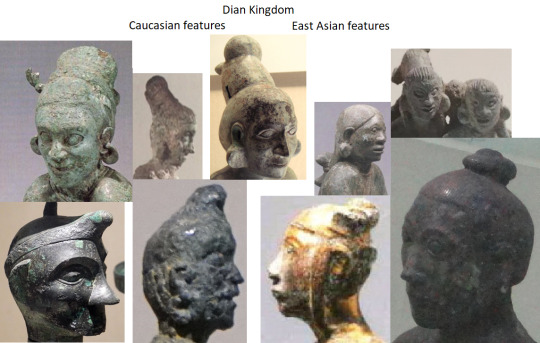

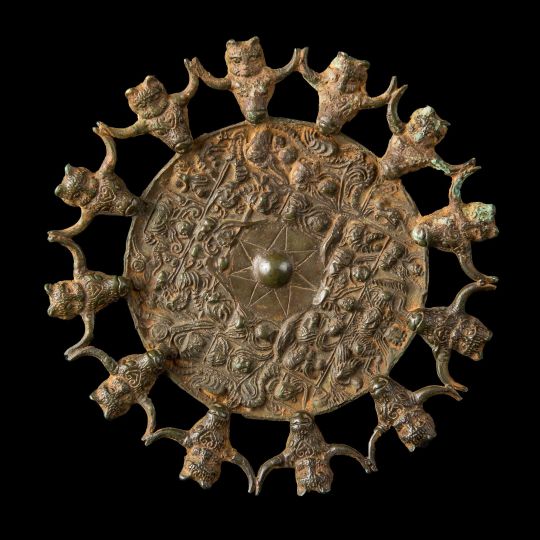
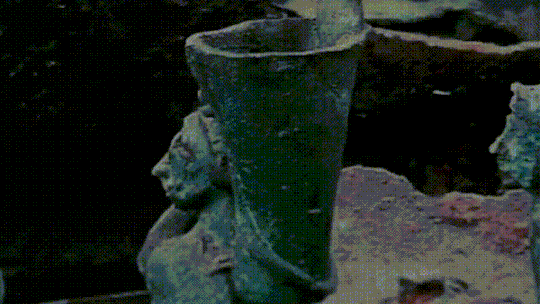

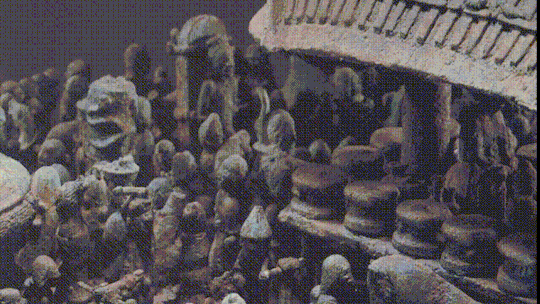

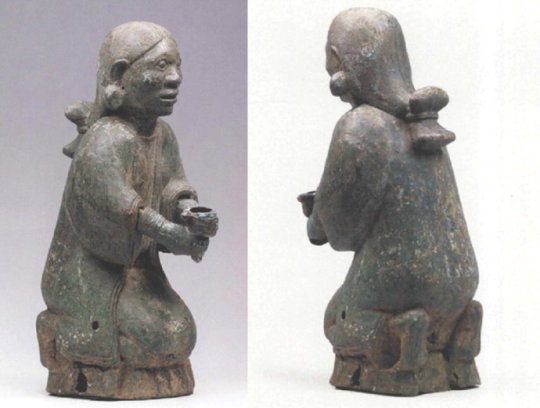

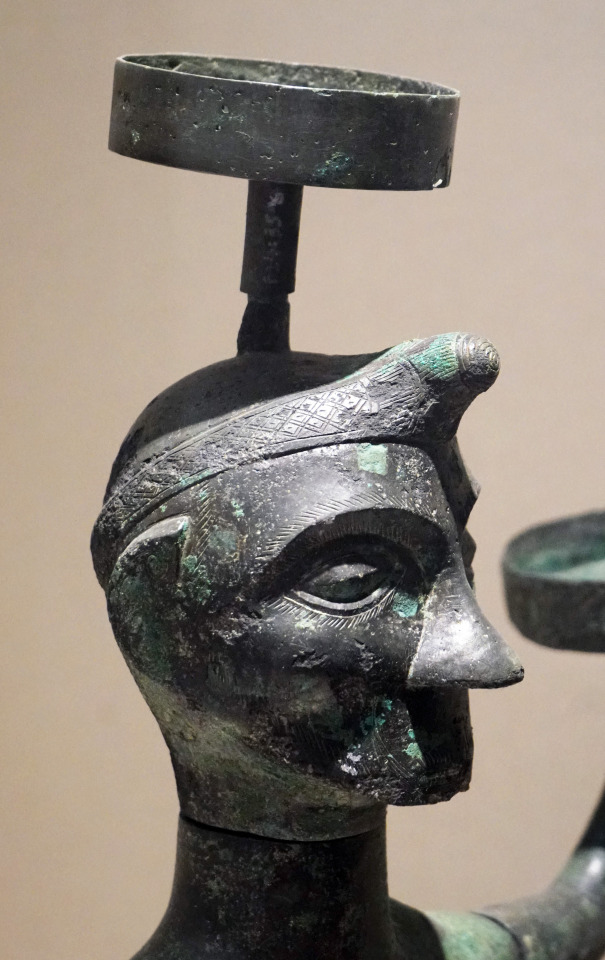

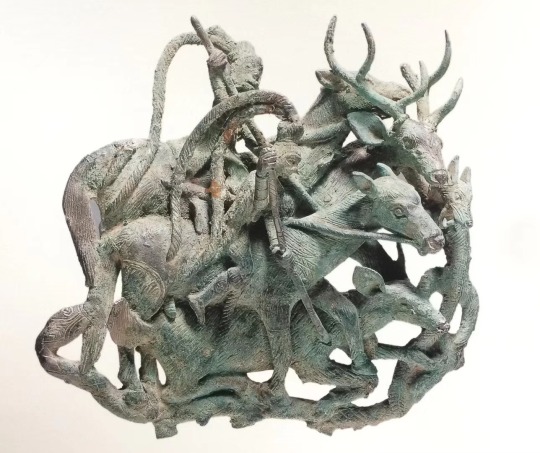





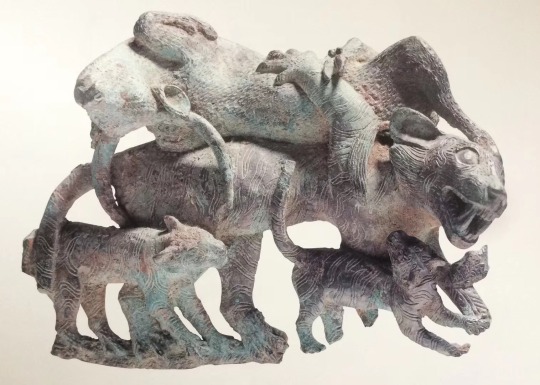

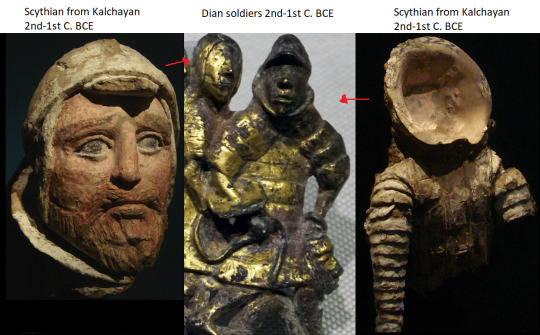
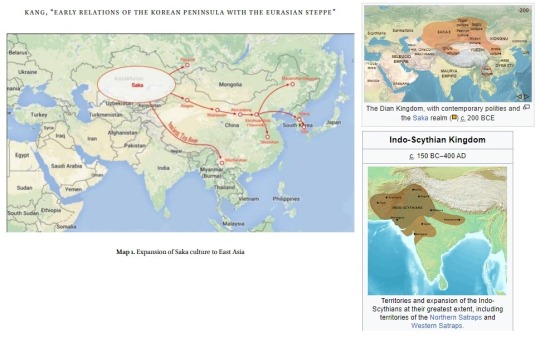


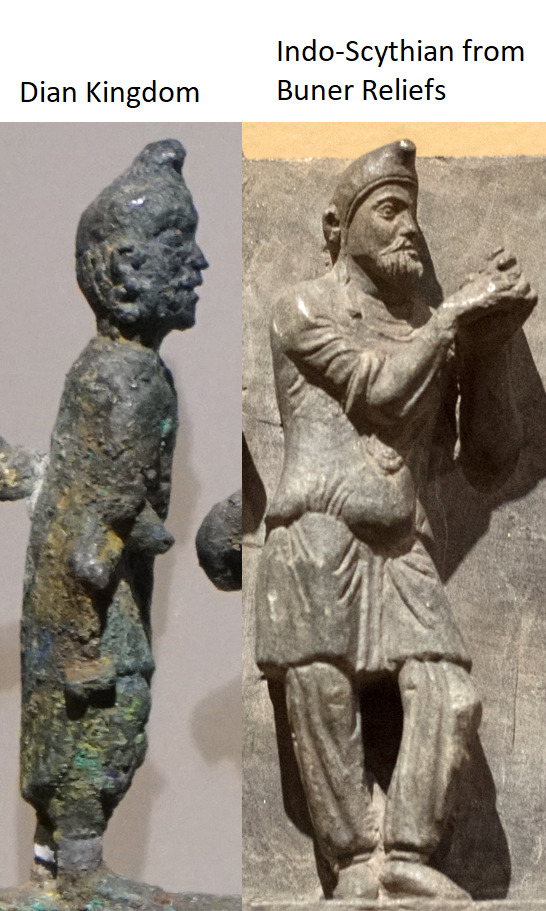


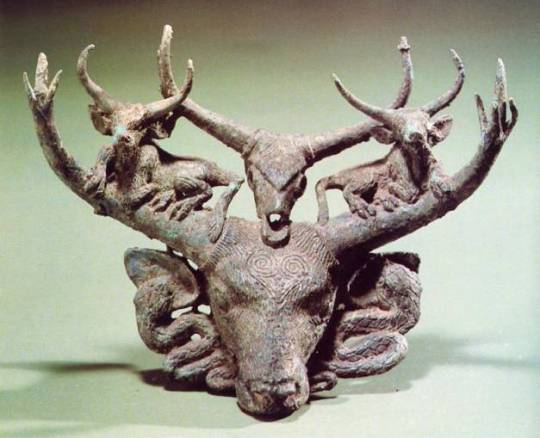
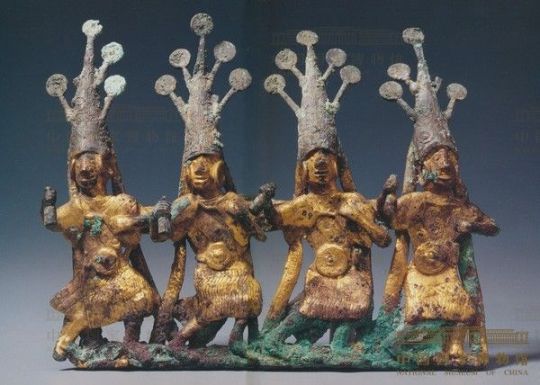


Dian Kingdom 8th-1st C. BCE. Meant to post this one a long time ago but it took me forever to put together. I'm just going to post 30 images here, I got about 100 total on my blog. Link at bottom.
The Dian Kingdom was an advanced civilization in what is modern-day southwest China. It was occupied by the Han Dynasty and incorporated into China after that. From what I've gathered, the people of the Dian Kingdom were probably closely related to the Baiyue people from southern China and northern Vietnam. Wikipedia says they may have spoke a Tibeto-Burman language. I found it interesting that some of these people look Caucasoid though and were wearing clothing similar to Scythians. The image I compared of the Dian man to the Indo-Scythian has a similar facial structure, hat, and even the same type of pants (sorry, I don't have time to tidy up the comparison photos more).
The Dian art theme of the four tigers attacking an ox is found in the same pre-Han period among the Xiongnu at Aluchaideng, and a similar motif appears at Tillya Tepe a couple centuries later. The theme is the same but the style is very different, still it indicates a connection to these places of the world through trade and exposure.
Some of the scenes with soldiers show a variety of different equipment styles and certain subjects have distinct fashion styles (like the people wearing the items that make their ears look huge). I watched a couple documentaries on genetics of the Dian and they were only able to find genetic info for one person, who was identified as similar to the Baiyue people. I'll link those youtube videos in sources below. I assume these people were primarily related to modern day Vietnamese and southern Chinese (or other people nearby) but may have had close interactions with (and even immigrants from) Scythian cultures despite their distance from them, which is interesting.
From the videos: "According to the final count, the amount of bronze ware excavated from Lijia Mountain is almost half the amount of the Shang Dynasty bronze ware excavated in Yinxu, Henan."
youtube
youtube
#ancient history#history#museums#art history#art#sculpture#statue#ancient china#china#vietnam#scythian#artifacts#antiquities#anthropology#archaeology#indo european#Youtube
272 notes
·
View notes